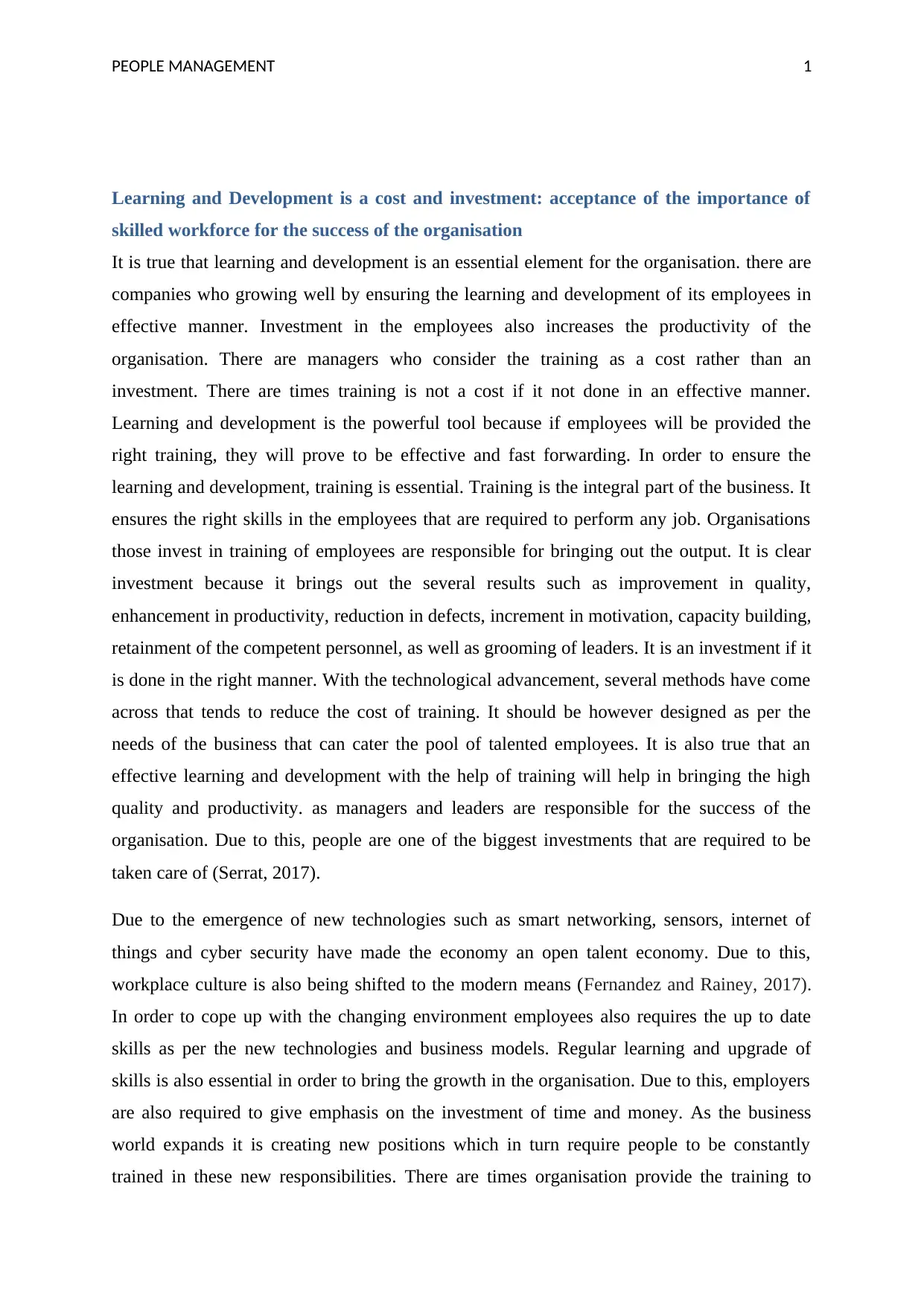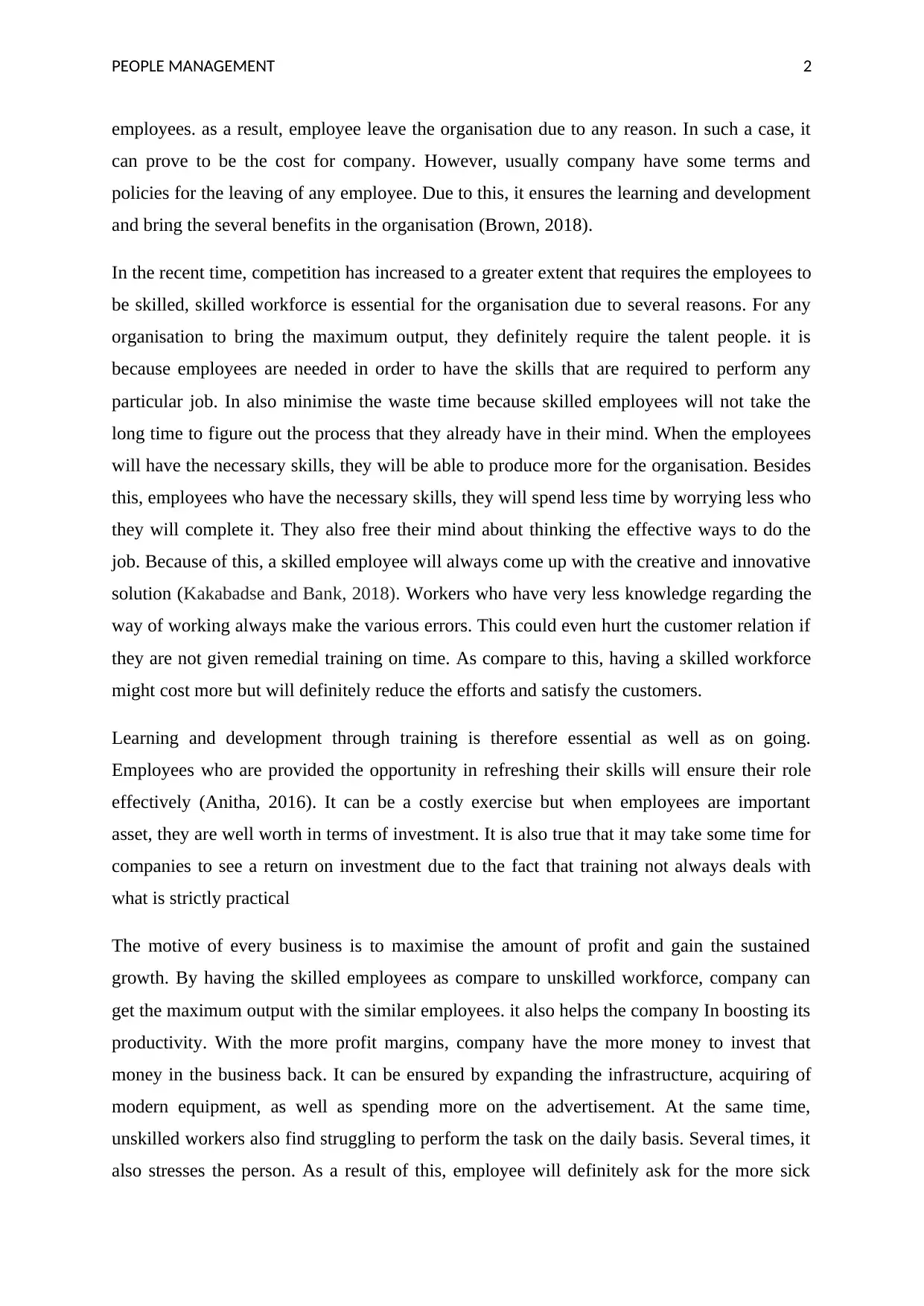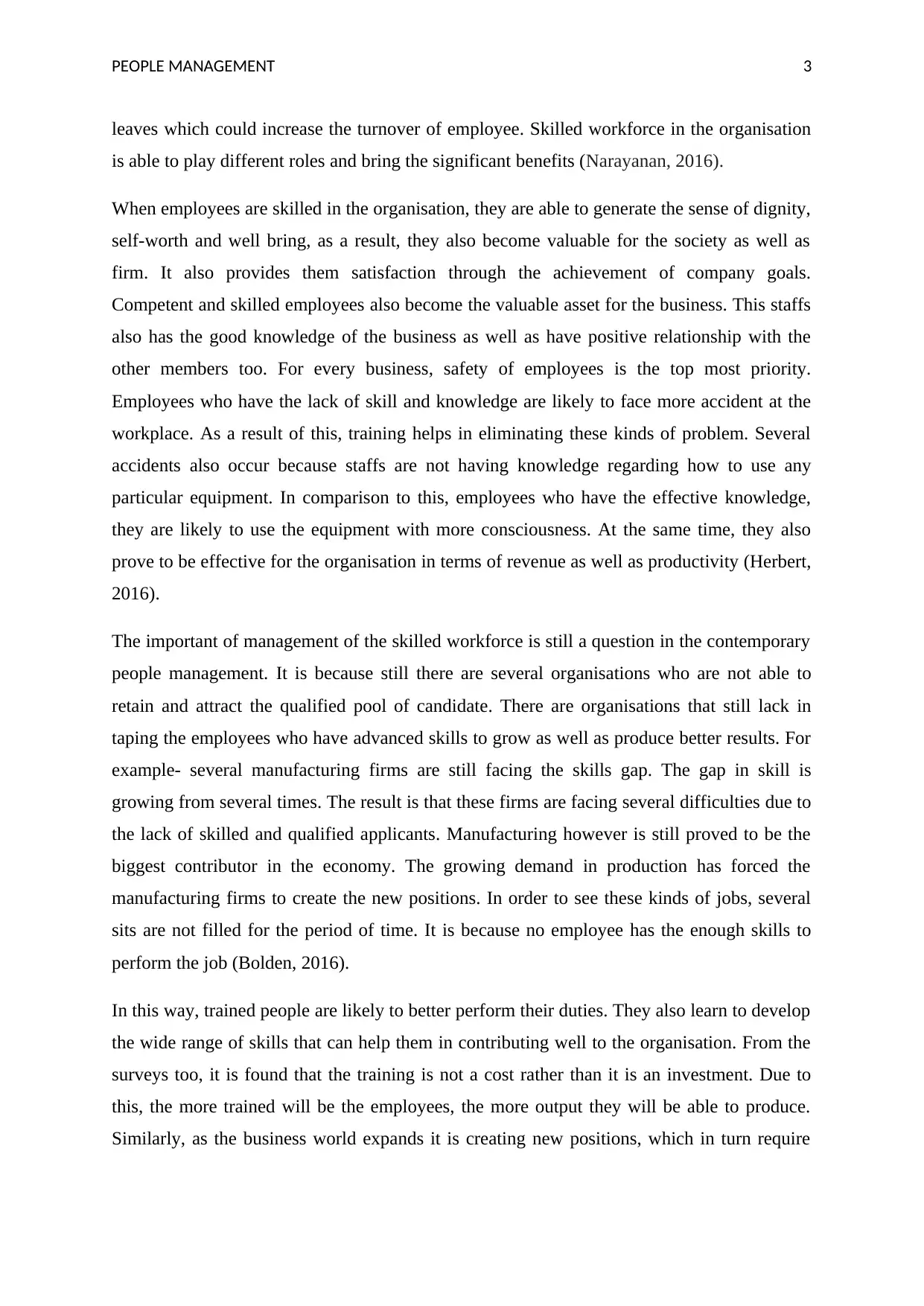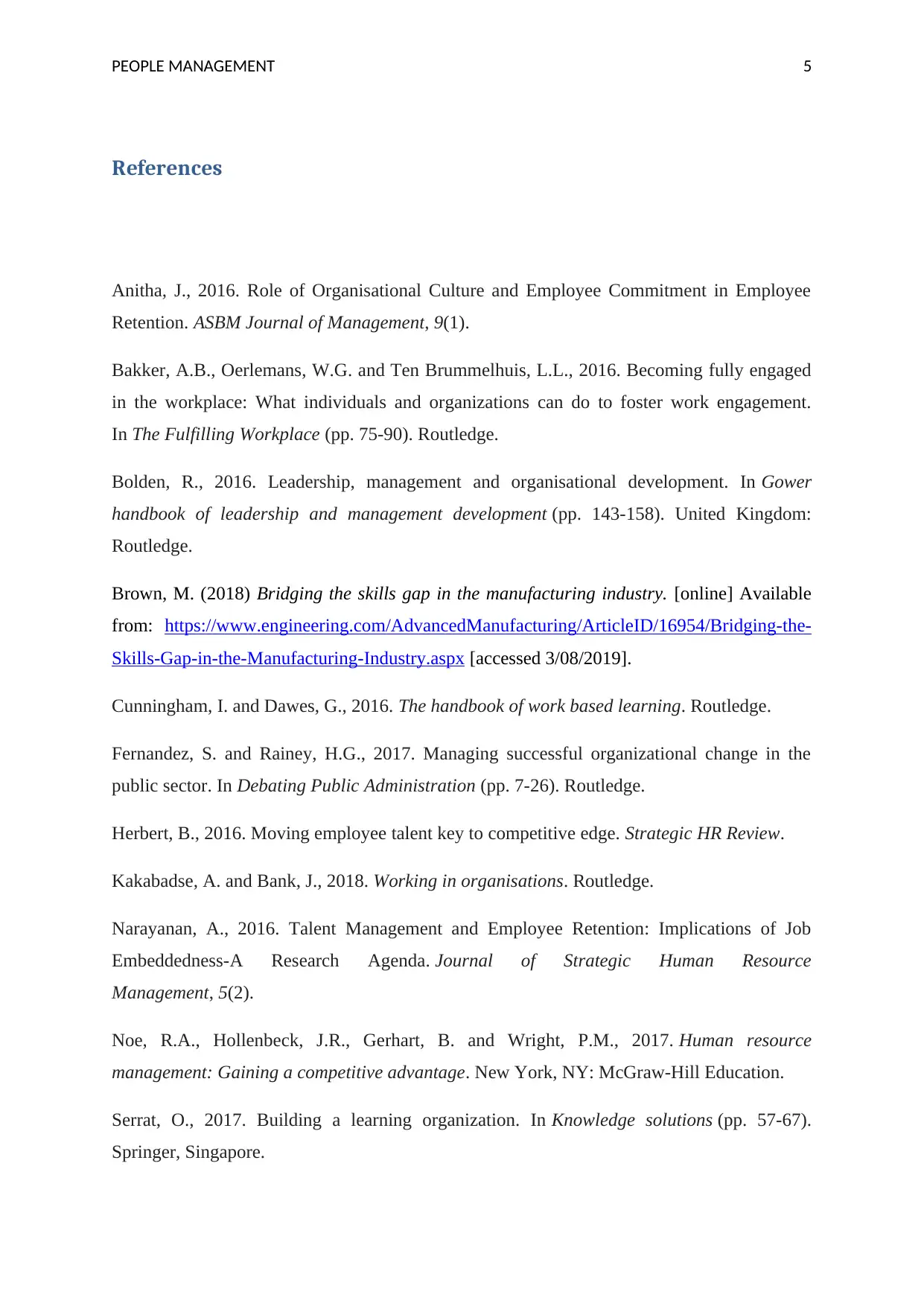People Management Report: Importance of Skilled Workforce Development
VerifiedAdded on 2022/10/11
|6
|1863
|16
Report
AI Summary
This report delves into the crucial role of people management, emphasizing the importance of a skilled workforce for organizational success. It highlights that investing in employee learning and development, particularly through training, is not merely a cost but a strategic investment that enhances productivity, quality, and employee retention. The report explores how technological advancements and evolving business models necessitate continuous skill upgrades. It addresses the benefits of a skilled workforce, including improved efficiency, innovation, and customer satisfaction, while also acknowledging the challenges such as the skills gap in certain industries. The report underscores the need for organizations to prioritize employee training and development to foster a competent and adaptable workforce, ultimately leading to enhanced profitability and sustainable growth. The content also references various sources to support the arguments presented.

Running head: PEOPLE MANAGEMENT 0
Management
Management
Paraphrase This Document
Need a fresh take? Get an instant paraphrase of this document with our AI Paraphraser

PEOPLE MANAGEMENT 1
Learning and Development is a cost and investment: acceptance of the importance of
skilled workforce for the success of the organisation
It is true that learning and development is an essential element for the organisation. there are
companies who growing well by ensuring the learning and development of its employees in
effective manner. Investment in the employees also increases the productivity of the
organisation. There are managers who consider the training as a cost rather than an
investment. There are times training is not a cost if it not done in an effective manner.
Learning and development is the powerful tool because if employees will be provided the
right training, they will prove to be effective and fast forwarding. In order to ensure the
learning and development, training is essential. Training is the integral part of the business. It
ensures the right skills in the employees that are required to perform any job. Organisations
those invest in training of employees are responsible for bringing out the output. It is clear
investment because it brings out the several results such as improvement in quality,
enhancement in productivity, reduction in defects, increment in motivation, capacity building,
retainment of the competent personnel, as well as grooming of leaders. It is an investment if it
is done in the right manner. With the technological advancement, several methods have come
across that tends to reduce the cost of training. It should be however designed as per the
needs of the business that can cater the pool of talented employees. It is also true that an
effective learning and development with the help of training will help in bringing the high
quality and productivity. as managers and leaders are responsible for the success of the
organisation. Due to this, people are one of the biggest investments that are required to be
taken care of (Serrat, 2017).
Due to the emergence of new technologies such as smart networking, sensors, internet of
things and cyber security have made the economy an open talent economy. Due to this,
workplace culture is also being shifted to the modern means (Fernandez and Rainey, 2017).
In order to cope up with the changing environment employees also requires the up to date
skills as per the new technologies and business models. Regular learning and upgrade of
skills is also essential in order to bring the growth in the organisation. Due to this, employers
are also required to give emphasis on the investment of time and money. As the business
world expands it is creating new positions which in turn require people to be constantly
trained in these new responsibilities. There are times organisation provide the training to
Learning and Development is a cost and investment: acceptance of the importance of
skilled workforce for the success of the organisation
It is true that learning and development is an essential element for the organisation. there are
companies who growing well by ensuring the learning and development of its employees in
effective manner. Investment in the employees also increases the productivity of the
organisation. There are managers who consider the training as a cost rather than an
investment. There are times training is not a cost if it not done in an effective manner.
Learning and development is the powerful tool because if employees will be provided the
right training, they will prove to be effective and fast forwarding. In order to ensure the
learning and development, training is essential. Training is the integral part of the business. It
ensures the right skills in the employees that are required to perform any job. Organisations
those invest in training of employees are responsible for bringing out the output. It is clear
investment because it brings out the several results such as improvement in quality,
enhancement in productivity, reduction in defects, increment in motivation, capacity building,
retainment of the competent personnel, as well as grooming of leaders. It is an investment if it
is done in the right manner. With the technological advancement, several methods have come
across that tends to reduce the cost of training. It should be however designed as per the
needs of the business that can cater the pool of talented employees. It is also true that an
effective learning and development with the help of training will help in bringing the high
quality and productivity. as managers and leaders are responsible for the success of the
organisation. Due to this, people are one of the biggest investments that are required to be
taken care of (Serrat, 2017).
Due to the emergence of new technologies such as smart networking, sensors, internet of
things and cyber security have made the economy an open talent economy. Due to this,
workplace culture is also being shifted to the modern means (Fernandez and Rainey, 2017).
In order to cope up with the changing environment employees also requires the up to date
skills as per the new technologies and business models. Regular learning and upgrade of
skills is also essential in order to bring the growth in the organisation. Due to this, employers
are also required to give emphasis on the investment of time and money. As the business
world expands it is creating new positions which in turn require people to be constantly
trained in these new responsibilities. There are times organisation provide the training to

PEOPLE MANAGEMENT 2
employees. as a result, employee leave the organisation due to any reason. In such a case, it
can prove to be the cost for company. However, usually company have some terms and
policies for the leaving of any employee. Due to this, it ensures the learning and development
and bring the several benefits in the organisation (Brown, 2018).
In the recent time, competition has increased to a greater extent that requires the employees to
be skilled, skilled workforce is essential for the organisation due to several reasons. For any
organisation to bring the maximum output, they definitely require the talent people. it is
because employees are needed in order to have the skills that are required to perform any
particular job. In also minimise the waste time because skilled employees will not take the
long time to figure out the process that they already have in their mind. When the employees
will have the necessary skills, they will be able to produce more for the organisation. Besides
this, employees who have the necessary skills, they will spend less time by worrying less who
they will complete it. They also free their mind about thinking the effective ways to do the
job. Because of this, a skilled employee will always come up with the creative and innovative
solution (Kakabadse and Bank, 2018). Workers who have very less knowledge regarding the
way of working always make the various errors. This could even hurt the customer relation if
they are not given remedial training on time. As compare to this, having a skilled workforce
might cost more but will definitely reduce the efforts and satisfy the customers.
Learning and development through training is therefore essential as well as on going.
Employees who are provided the opportunity in refreshing their skills will ensure their role
effectively (Anitha, 2016). It can be a costly exercise but when employees are important
asset, they are well worth in terms of investment. It is also true that it may take some time for
companies to see a return on investment due to the fact that training not always deals with
what is strictly practical
The motive of every business is to maximise the amount of profit and gain the sustained
growth. By having the skilled employees as compare to unskilled workforce, company can
get the maximum output with the similar employees. it also helps the company In boosting its
productivity. With the more profit margins, company have the more money to invest that
money in the business back. It can be ensured by expanding the infrastructure, acquiring of
modern equipment, as well as spending more on the advertisement. At the same time,
unskilled workers also find struggling to perform the task on the daily basis. Several times, it
also stresses the person. As a result of this, employee will definitely ask for the more sick
employees. as a result, employee leave the organisation due to any reason. In such a case, it
can prove to be the cost for company. However, usually company have some terms and
policies for the leaving of any employee. Due to this, it ensures the learning and development
and bring the several benefits in the organisation (Brown, 2018).
In the recent time, competition has increased to a greater extent that requires the employees to
be skilled, skilled workforce is essential for the organisation due to several reasons. For any
organisation to bring the maximum output, they definitely require the talent people. it is
because employees are needed in order to have the skills that are required to perform any
particular job. In also minimise the waste time because skilled employees will not take the
long time to figure out the process that they already have in their mind. When the employees
will have the necessary skills, they will be able to produce more for the organisation. Besides
this, employees who have the necessary skills, they will spend less time by worrying less who
they will complete it. They also free their mind about thinking the effective ways to do the
job. Because of this, a skilled employee will always come up with the creative and innovative
solution (Kakabadse and Bank, 2018). Workers who have very less knowledge regarding the
way of working always make the various errors. This could even hurt the customer relation if
they are not given remedial training on time. As compare to this, having a skilled workforce
might cost more but will definitely reduce the efforts and satisfy the customers.
Learning and development through training is therefore essential as well as on going.
Employees who are provided the opportunity in refreshing their skills will ensure their role
effectively (Anitha, 2016). It can be a costly exercise but when employees are important
asset, they are well worth in terms of investment. It is also true that it may take some time for
companies to see a return on investment due to the fact that training not always deals with
what is strictly practical
The motive of every business is to maximise the amount of profit and gain the sustained
growth. By having the skilled employees as compare to unskilled workforce, company can
get the maximum output with the similar employees. it also helps the company In boosting its
productivity. With the more profit margins, company have the more money to invest that
money in the business back. It can be ensured by expanding the infrastructure, acquiring of
modern equipment, as well as spending more on the advertisement. At the same time,
unskilled workers also find struggling to perform the task on the daily basis. Several times, it
also stresses the person. As a result of this, employee will definitely ask for the more sick
⊘ This is a preview!⊘
Do you want full access?
Subscribe today to unlock all pages.

Trusted by 1+ million students worldwide

PEOPLE MANAGEMENT 3
leaves which could increase the turnover of employee. Skilled workforce in the organisation
is able to play different roles and bring the significant benefits (Narayanan, 2016).
When employees are skilled in the organisation, they are able to generate the sense of dignity,
self-worth and well bring, as a result, they also become valuable for the society as well as
firm. It also provides them satisfaction through the achievement of company goals.
Competent and skilled employees also become the valuable asset for the business. This staffs
also has the good knowledge of the business as well as have positive relationship with the
other members too. For every business, safety of employees is the top most priority.
Employees who have the lack of skill and knowledge are likely to face more accident at the
workplace. As a result of this, training helps in eliminating these kinds of problem. Several
accidents also occur because staffs are not having knowledge regarding how to use any
particular equipment. In comparison to this, employees who have the effective knowledge,
they are likely to use the equipment with more consciousness. At the same time, they also
prove to be effective for the organisation in terms of revenue as well as productivity (Herbert,
2016).
The important of management of the skilled workforce is still a question in the contemporary
people management. It is because still there are several organisations who are not able to
retain and attract the qualified pool of candidate. There are organisations that still lack in
taping the employees who have advanced skills to grow as well as produce better results. For
example- several manufacturing firms are still facing the skills gap. The gap in skill is
growing from several times. The result is that these firms are facing several difficulties due to
the lack of skilled and qualified applicants. Manufacturing however is still proved to be the
biggest contributor in the economy. The growing demand in production has forced the
manufacturing firms to create the new positions. In order to see these kinds of jobs, several
sits are not filled for the period of time. It is because no employee has the enough skills to
perform the job (Bolden, 2016).
In this way, trained people are likely to better perform their duties. They also learn to develop
the wide range of skills that can help them in contributing well to the organisation. From the
surveys too, it is found that the training is not a cost rather than it is an investment. Due to
this, the more trained will be the employees, the more output they will be able to produce.
Similarly, as the business world expands it is creating new positions, which in turn require
leaves which could increase the turnover of employee. Skilled workforce in the organisation
is able to play different roles and bring the significant benefits (Narayanan, 2016).
When employees are skilled in the organisation, they are able to generate the sense of dignity,
self-worth and well bring, as a result, they also become valuable for the society as well as
firm. It also provides them satisfaction through the achievement of company goals.
Competent and skilled employees also become the valuable asset for the business. This staffs
also has the good knowledge of the business as well as have positive relationship with the
other members too. For every business, safety of employees is the top most priority.
Employees who have the lack of skill and knowledge are likely to face more accident at the
workplace. As a result of this, training helps in eliminating these kinds of problem. Several
accidents also occur because staffs are not having knowledge regarding how to use any
particular equipment. In comparison to this, employees who have the effective knowledge,
they are likely to use the equipment with more consciousness. At the same time, they also
prove to be effective for the organisation in terms of revenue as well as productivity (Herbert,
2016).
The important of management of the skilled workforce is still a question in the contemporary
people management. It is because still there are several organisations who are not able to
retain and attract the qualified pool of candidate. There are organisations that still lack in
taping the employees who have advanced skills to grow as well as produce better results. For
example- several manufacturing firms are still facing the skills gap. The gap in skill is
growing from several times. The result is that these firms are facing several difficulties due to
the lack of skilled and qualified applicants. Manufacturing however is still proved to be the
biggest contributor in the economy. The growing demand in production has forced the
manufacturing firms to create the new positions. In order to see these kinds of jobs, several
sits are not filled for the period of time. It is because no employee has the enough skills to
perform the job (Bolden, 2016).
In this way, trained people are likely to better perform their duties. They also learn to develop
the wide range of skills that can help them in contributing well to the organisation. From the
surveys too, it is found that the training is not a cost rather than it is an investment. Due to
this, the more trained will be the employees, the more output they will be able to produce.
Similarly, as the business world expands it is creating new positions, which in turn require
Paraphrase This Document
Need a fresh take? Get an instant paraphrase of this document with our AI Paraphraser

PEOPLE MANAGEMENT 4
people to be constantly trained in these new responsibilities (Noe, Hollenbeck, Gerhart and
Wright, 2017).
people to be constantly trained in these new responsibilities (Noe, Hollenbeck, Gerhart and
Wright, 2017).

PEOPLE MANAGEMENT 5
References
Anitha, J., 2016. Role of Organisational Culture and Employee Commitment in Employee
Retention. ASBM Journal of Management, 9(1).
Bakker, A.B., Oerlemans, W.G. and Ten Brummelhuis, L.L., 2016. Becoming fully engaged
in the workplace: What individuals and organizations can do to foster work engagement.
In The Fulfilling Workplace (pp. 75-90). Routledge.
Bolden, R., 2016. Leadership, management and organisational development. In Gower
handbook of leadership and management development (pp. 143-158). United Kingdom:
Routledge.
Brown, M. (2018) Bridging the skills gap in the manufacturing industry. [online] Available
from: https://www.engineering.com/AdvancedManufacturing/ArticleID/16954/Bridging-the-
Skills-Gap-in-the-Manufacturing-Industry.aspx [accessed 3/08/2019].
Cunningham, I. and Dawes, G., 2016. The handbook of work based learning. Routledge.
Fernandez, S. and Rainey, H.G., 2017. Managing successful organizational change in the
public sector. In Debating Public Administration (pp. 7-26). Routledge.
Herbert, B., 2016. Moving employee talent key to competitive edge. Strategic HR Review.
Kakabadse, A. and Bank, J., 2018. Working in organisations. Routledge.
Narayanan, A., 2016. Talent Management and Employee Retention: Implications of Job
Embeddedness-A Research Agenda. Journal of Strategic Human Resource
Management, 5(2).
Noe, R.A., Hollenbeck, J.R., Gerhart, B. and Wright, P.M., 2017. Human resource
management: Gaining a competitive advantage. New York, NY: McGraw-Hill Education.
Serrat, O., 2017. Building a learning organization. In Knowledge solutions (pp. 57-67).
Springer, Singapore.
References
Anitha, J., 2016. Role of Organisational Culture and Employee Commitment in Employee
Retention. ASBM Journal of Management, 9(1).
Bakker, A.B., Oerlemans, W.G. and Ten Brummelhuis, L.L., 2016. Becoming fully engaged
in the workplace: What individuals and organizations can do to foster work engagement.
In The Fulfilling Workplace (pp. 75-90). Routledge.
Bolden, R., 2016. Leadership, management and organisational development. In Gower
handbook of leadership and management development (pp. 143-158). United Kingdom:
Routledge.
Brown, M. (2018) Bridging the skills gap in the manufacturing industry. [online] Available
from: https://www.engineering.com/AdvancedManufacturing/ArticleID/16954/Bridging-the-
Skills-Gap-in-the-Manufacturing-Industry.aspx [accessed 3/08/2019].
Cunningham, I. and Dawes, G., 2016. The handbook of work based learning. Routledge.
Fernandez, S. and Rainey, H.G., 2017. Managing successful organizational change in the
public sector. In Debating Public Administration (pp. 7-26). Routledge.
Herbert, B., 2016. Moving employee talent key to competitive edge. Strategic HR Review.
Kakabadse, A. and Bank, J., 2018. Working in organisations. Routledge.
Narayanan, A., 2016. Talent Management and Employee Retention: Implications of Job
Embeddedness-A Research Agenda. Journal of Strategic Human Resource
Management, 5(2).
Noe, R.A., Hollenbeck, J.R., Gerhart, B. and Wright, P.M., 2017. Human resource
management: Gaining a competitive advantage. New York, NY: McGraw-Hill Education.
Serrat, O., 2017. Building a learning organization. In Knowledge solutions (pp. 57-67).
Springer, Singapore.
⊘ This is a preview!⊘
Do you want full access?
Subscribe today to unlock all pages.

Trusted by 1+ million students worldwide
1 out of 6
Related Documents
Your All-in-One AI-Powered Toolkit for Academic Success.
+13062052269
info@desklib.com
Available 24*7 on WhatsApp / Email
![[object Object]](/_next/static/media/star-bottom.7253800d.svg)
Unlock your academic potential
Copyright © 2020–2025 A2Z Services. All Rights Reserved. Developed and managed by ZUCOL.




